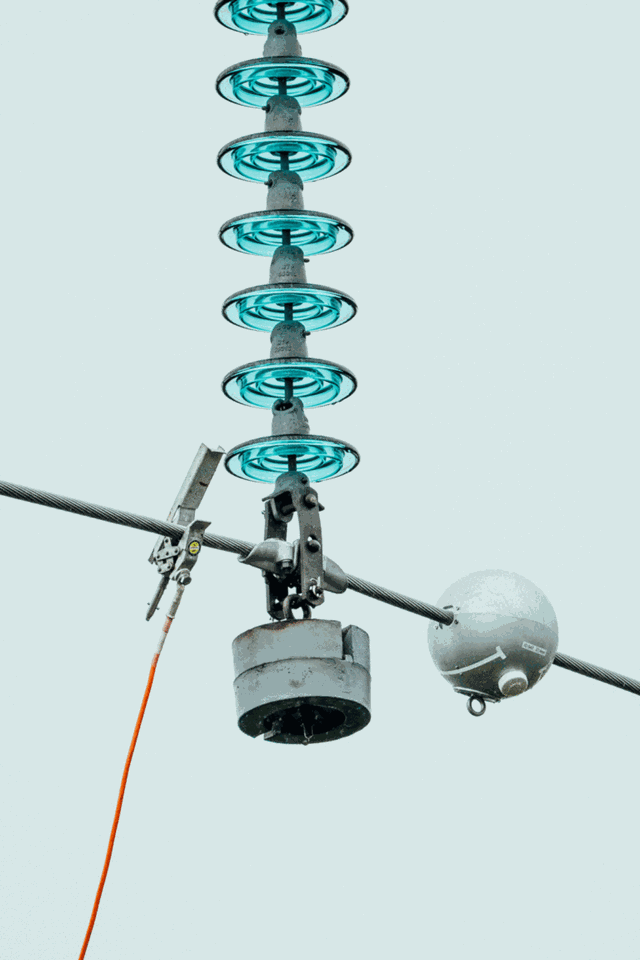The grey sphere is about the size of a bowling ball. It’s full of sensors and will allow more electricity to run through the power lines.
“What’s important is that we utilize the network we’ve already built in a safe way,” says Maren Istad, who works with energy systems at SINTEF.
The researcher has collaborated with several grid companies to find out what the grey ball can do when it is attached to the line. The Norwegian company Heimdall Power has developed the ball and named it the “Neuron.”
Grid rent is getting more expensive
“The company’s main goal has been to look at how we can deliver greater flexibility and make better use of the power system we have,” says Therese Åsheim, a project manager at Heimdall Power.
When you pay your electricity bill, you pay one company to produce the electricity and one company to rent space on the power grid. The Norwegian Water Resources and Energy Directorate (NVE) has determined that grid rent will be increasing in the coming years.
“The company’s main goal has been to look at how we can deliver greater flexibility and make better use of the power system we have.
Limited space on the grid means that new power lines will need to be built if everyone is to get the electricity they need. New power lines are expensive to build, and they are controversial due their environmental impacts.
Transmission lines have space
Usually, however, the existing lines actually do have space. This space is what the Neurons from Heimdall Power track by collecting data to find out what the real capacity is at any given time.
The electrical line capacity varies as the weather changes. If it is windy and cold at the same time, the lines can transmit significantly more electricity than what the current limits allow. Both wind and cold cool the lines, which makes the actual transmission capacity higher.
Locating free capacity
Today, most power lines operate based on best guesses about the weather. How much power we allow in the lines is limited by conservative safety margins – because we do not know for sure what their actual capacity is.
Åsheim explains that insight into the lines’ actual capacity is precisely what the sensors provide. The technology has already been proven in the field and shown that the potential for utilizing increased capacity is great. Now Heimdall Power is working with the grid companies to take advantage of this potential.
The findings show that power lines often have a greater capacity than the current operating limits. “The increase is as much as 35 MW for some lines,” she says. On average, the lines that are equipped with Neurons have approximately 40 percent more capacity.
Facts about CINELDI:
The research on the Neuron and the capacity in the power grid has been part of the CINELDI research Centre for intelligent electricity distribution and is one of Norway’s Centres for Environment-friendly Energy Research (FME).
CINELDI has carried out 33 pilot projects with different technologies and solutions for a flexible and intelligent power grid over the past eight years.
SINTEF Energy Research has led the research centre. The 30 partners include researchers, , grid companies, system operators, technology providers and authorities.
Six grid companies have participated in a large-scale pilot project led by Heimdall Power. They have explored the potential of digitalizing the high-voltage line network. The goal has been to investigate how sensors can provide greater flexibility in the power system and create value for grid companies.
Several adjacent lines with different voltages have been equipped with sensors to collect data and test the possibilities that the technology offers on a large scale.
Reduce grid expansion costs
Istad emphasizes that the Neuron spheres are able to contribute information that the grid companies have not had access to before. “Now what still needs to be done is to get this information into the operation centres and use it in regular operations, so that the existing grid can be utilized in the best possible way,” she says.
Istad describes how a better overview of capacity also opens up new jobs. Today, industrial projects often have to wait to access enough electricity to establish themselves, to expand their processes or make them greener. They may now be able to reduce that waiting time.

A drone installs the Neuron sensor node on a power cable. Photo: Heimdall Power
“By utilizing the existing capacity in the current power grid, we can in some cases avoid building a new power grid. This spares nature from major environmental encroachment,” says Istad.
“The benefit lies in the fact that we can reduce the costs of operating the grid, postpone investments in the grid and achieve faster electrification and connection of renewable power. The research results we have obtained in the project support the theory we’ve had about this,” Åsheim says.


